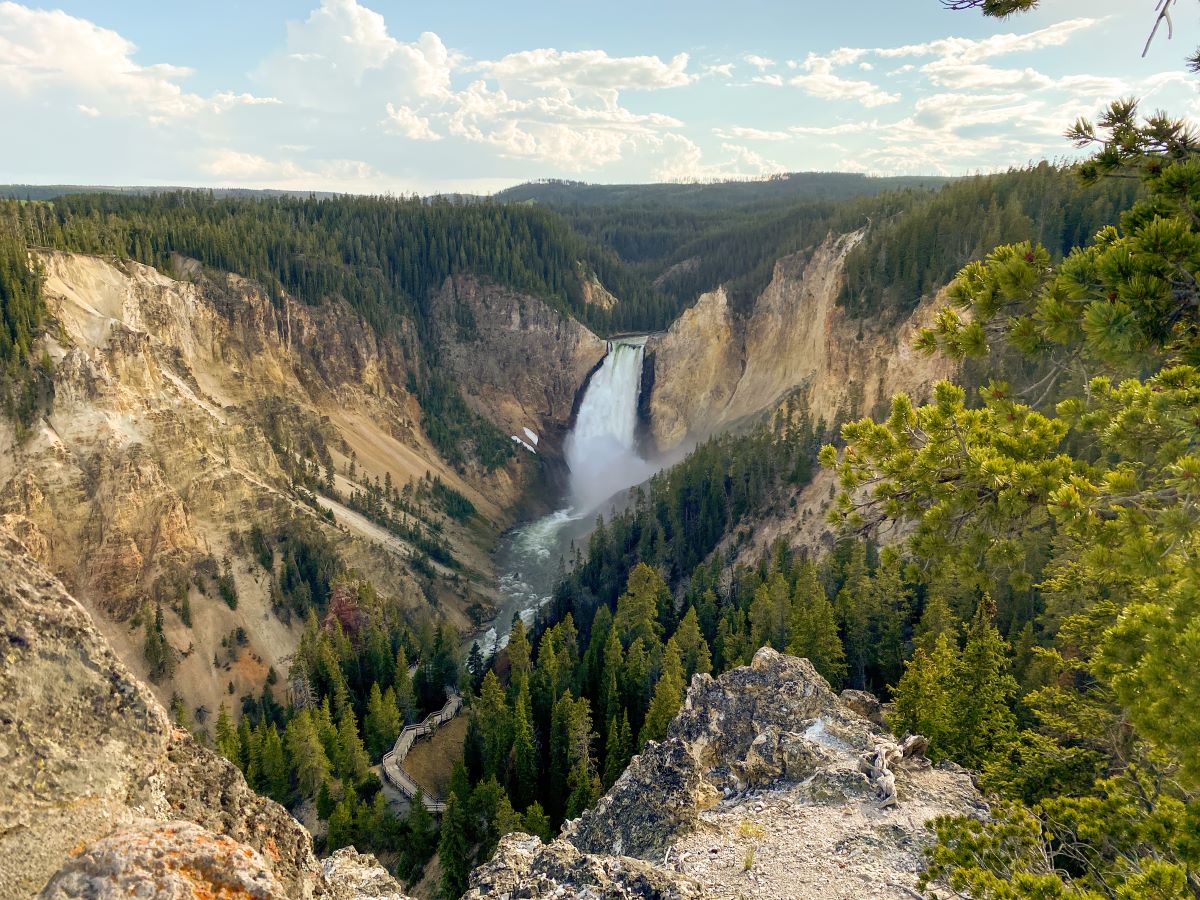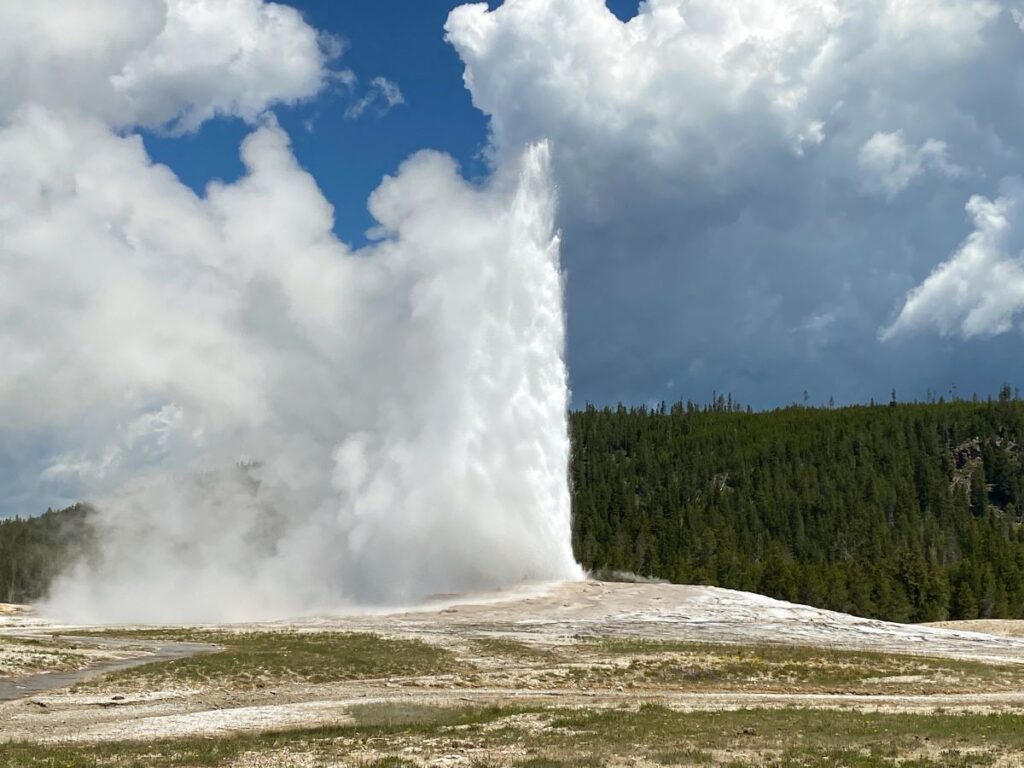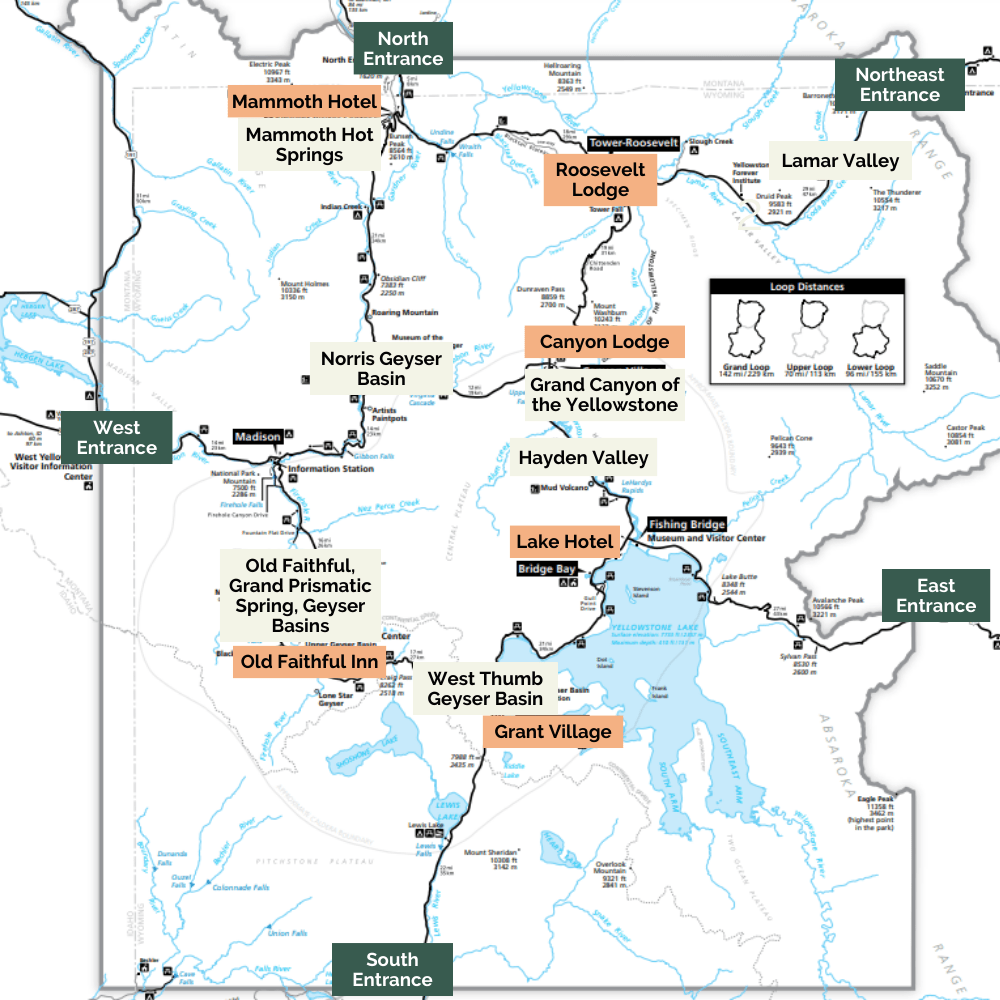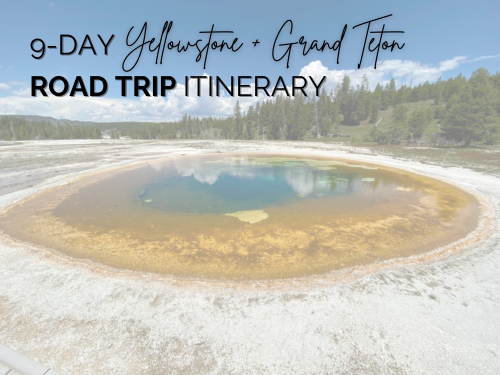
YELLOWSTONE National Park
Yellowstone is the world’s first National Park, earning it’s status in 1872. It is one of the most geologically diverse areas in the world and is home to some really unique features. Bubbling mud pots, massive hot springs, abundant wildlife, towering waterfalls, and pungent fumaroles are just a few of the wonders you’ll experience here!
Yellowstone is an absolutely massive park with so much to see and do. At over 3500 square miles with 5 entrances, 900 miles of hiking trails, 11 geyser basins, and its own Grand Canyon, there are no limits to the outdoor adventures you can have here.
Yellowstone is also one of the most visited National Parks, at just over 4 million visitors per year. Expect enormous crowds during the summer due to the short tourist season and popularity.
Yellowstone Facts
Annual Visitors: 4.5 million in 2023
Size: 2.2 million acres
Location: Wyoming, Montana, & Idaho (most of its land is in Wyoming)
Year Founded: March 1, 1872
Entrance Fee: $35
Reservations Required?: No

Best Things to Do in Yellowstone
OLD FAITHFUL & UPPER GEYSER BASIN: Visit the park’s crown jewel and watch Old Faithful erupt from the viewing area. Old Faithful erupts every 35 – 120 minutes and an eruption lasts between 1.5 and 5 minutes. Don’t forget to spend time walking the boardwalk trails to see other colorful hot springs in the Upper Geyser Basin!
GRAND PRISMATIC SPRING: One of the world’s largest and most colorful hot springs, Grand Prismatic Spring is a must-see at Yellowstone. Walk the boardwalk trails at Midway Geyser Basin and hike up to the Grand Prismatic Spring Overlook for a birds’ eye view. Go midday to see the brightest colors when the sun is overhead.
GRAND CANYON OF THE YELLOWSTONE: The Grand Canyon of the Yellowstone is a 20-mile long canyon carved by the Yellowstone River. This area is unique because it is also home to geothermal activity. 2 of the 3 major waterfalls on the Yellowstone River are also located here, the Upper and Lower Falls. Drive to each of the viewpoints on the North and South Rim and admire the view!
MAMMOTH HOT SPRINGS: The Mammoth Hot Springs do live up to their name- they are huge! Admire these ever-changing terraces filled with water and bacteria creating the perfect copper colors draping over layers of travertine. Walk both the upper and lower terraces for the ultimate experience.
WILDLIFE SPOTTING: Yellowstone is home to a ton of amazing wildlife, including bison, elk, bear, coyotes, bighorn sheep, and more. Lamar Valley and Hayden Valley are 2 of the best places to see wildlife. Go early in the morning or in the evening when the animals are most active for the best chance at viewing wildlife!
NORRIS GEYSER BASIN: Visit Yellowstone’s oldest, hottest, and most dynamic geyser basin via 2 boardwalk trails. Highlights include Steamboat Geyser, the tallest active geyser in the world with a spray of over 300 feet!
HIKE TO MT. WASHBURN: The Mt. Washburn peak is the second highest point in Yellowstone. You can hike to the top via a 6.8-mile strenuous trail and be rewarded with panoramic views over the entire park. Don’t forget your bear spray!
LOWER GEYSER BASIN & FOUNTAIN PAINT POT TRAIL: There are 2 ways to visit the Lower Geyser Basin: walking the 0.8-mile Fountain Paint Pots boardwalk trail and driving Firehole Lake Drive. This area is a great place to see mudpots!
DRIVE THE BEARTOOTH HIGHWAY: The Beartooth Highway is a spectacularly thrilling 68-mile scenic drive located on the stretch of highway between Red Lodge and Cooke City, Montana. It’s easy to add on this drive if you come from the Bozeman or Billings airport. The road will lead you right to the Yellowstone northeast entrance.
WEST THUMB GEYSER BASIN: West Thumb Geyser Basin is unique because it is located right on the Yellowstone Lake. A stop here is short and sweet, plus it is less crowded than some of the other geyser basins in Yellowstone.
ROOSEVELT ARCH: Just north of the north entrance gate is the Teddy Roosevelt Arch. The arch was actually built in 1903, even though the plaque has a quote from the 1872 legislation establishing Yellowstone as the world’s first National Park.
When to Visit
The best time to visit Yellowstone National Park is in the summer. Most of the park roads are closed from October to May due to weather and snow, so it’s really tough to see the best attractions if you travel during this time.
Yes, the summer will have enormous crowds, but the weather will be amazing and the direct sunlight will really make the colors in the hot springs pop! Structure your days so that you get an early start, rest during the middle of the day when crowds are highest, and then continue exploring after 4 pm for the best experience.
A happy medium between crowds and good weather is to visit in mid-September through early October. It will be cooler, but you’ll see a lot less crowds and see fall colors.
How Many Days Do You Need?
Try to reserve at least 3-5 days for visiting Yellowstone National Park. You can breeze by the main attractions in 2 or less days, but spending more time allows you to get off the beaten path and thoroughly explore each area at a more leisurely pace.
We spent 5 days in Yellowstone and I thought that it was the perfect amount of time.
How to Get There
Yellowstone National Park is mostly located in the northwest corner of Wyoming, but it also stretches into parts of Montana and Idaho.
Your best bet is to fly into Bozeman, Billings, or Jackson Hole and rent a car. Bozeman and Billings are about 2 hours away from the north and northeast entrances of Yellowstone, plus you’ll be able to drive the fantastic Beartooth Highway on your way to or from the park.
Flying into Jackson Hole works well if you also plan on visiting Grand Teton National Park on your trip to Yellowstone. Jackson Hole to the Yellowstone south entrance is about 1.5 hours.
Yellowstone does have it’s own airport located close to the west entrance, but it is small and flights are really expensive with long layovers, so I wouldn’t necessarily recomend flying this way.
The roads in Yellowstone form a figure 8 that connect all the main attractions in the park. Grand Loop Road is the main road on the outside, and Norris-Canyon Road divides the Grand Loop Road into a figure 8. The figure 8 is often referred to as the “North Loop” and the “South Loop.”
There are 5 entrances into Yellowstone and each one has a “gateway town” outside the entrance along with an in-park village with lodging, food, and gas stations (for more information on each of the Yellowstone entrances, gateway towns, and the best places to stay, check out this post).
Yellowstone National Park Map

Where to Stay
I highly recommend staying inside the park when visiting Yellowstone. Because of how large the park is, you will easily spend an hour or more driving between the nearest town outside the park and the best attractions. In order to maximize your time at Yellowstone, cut down on driving, and not get stuck waiting at park entrance gates, it makes sense to spend the extra money for the location convenience here.
Yellowstone has 9 lodges spread throughout 6 different areas inside the park:
- MAMMOTH VILLAGE: Near the north entrance and closest to Mammoth Hot Springs.
- TOWER-ROOSEVELT: Near the northeast entrance and closest to Lamar Valley.
- CANYON VILLAGE: Located along the rim of the Grand Canyon of the Yellowstone.
- LAKE VILLAGE: Near the east entrance and right on the Yellowstone Lake.
- GRANT VILLAGE: Near the south entrance and closest to West Thumb Geyser Basin. It isn’t too far from Old Faithful and Grand Prismatic Spring.
- OLD FAITHFUL: Located right at Old Faithful and Upper Geyser Basin. This area is located in the heart of geyser country and is the busiest area of the park.
The in-park lodges book up really fast, so book your accommodations 6-12 months in advance. I know that sounds crazy, but trust me. I booked our July trip in January and even then some of the lodges were completely sold out! All of the lodges are managed by Xanterra. More information and online booking can be found on their website here.
I also highly recommend staying in multiple locations within the park to cut down on driving time. Yes, it’s annoying to have to pack and unpack, but this will save you a ton of time. I talk about this strategy in more detail in my ultimate Yellowstone itinerary.
If you want to learn more about each Yellowstone entrance and the attractions located close by, check out my guide to all 5 Yellowstone entrances.
YELLOWSTONE ROAD TRIP IDEAS
Spend 9 days road tripping through Yellowstone and Grand Teton National Parks. This is a great trip to do if you have 5 days of PTO + 2 weekends to spend. You’ll spend 5 days visiting multiple locations in Yellowstone and 3 days exploring the Grand Tetons.
Customize your Yellowstone road trip with a perfectly optimized itinerary for 1, 2, 3, 4, or 5 days in Yellowstone National Park. A trip to Yellowstone is a great road trip in and of itself!
Only have 1 day to visit Yellowstone? No problem! Here are 7 different ways to road trip through Yellowstone National Park in just one day. Choose your starting and ending points and learn how to see the highlights of Yellowstone in just one day.
Learn how to add a road trip down the absolutely breathtaking Beartooth Highway to your Yellowstone trip. This full-day scenic drive is one of the most beautiful I have ever done.










